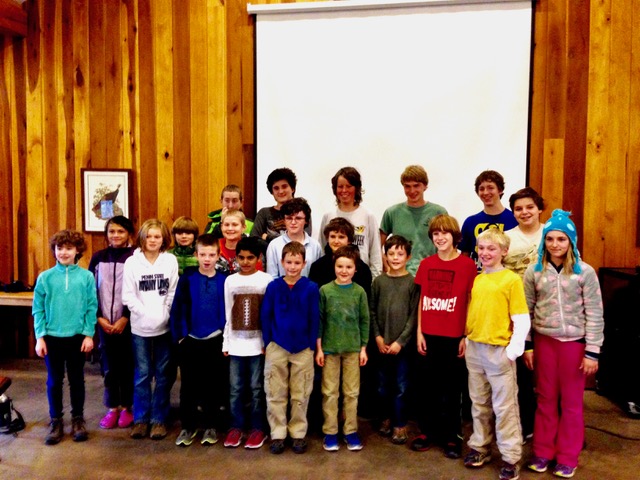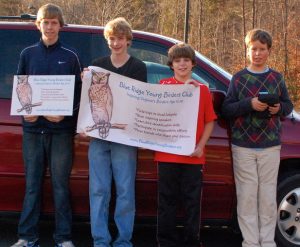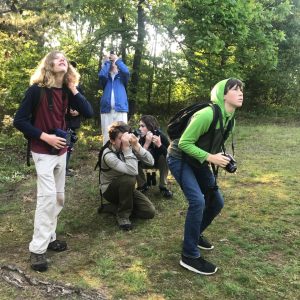By Eric Wallace

Meeting of the BRYBC at Ivy Creek (Dec 2014)
When Monticello Bird Club member Eve Gaige met Gabriel Mapel, he was 11-years-old. Bonding over a mutual love of birds, the two founded what is now Virginia’s largest and most active youth birding club.
Fifteen years ago, if you’d told hospital administrator Eve Gaige she would soon befriend an 11-year-old boy and co-found what is now Virginia’s largest and most active youth birding club, she would have dismissed you as a lunatic.
For one thing, the 69-year-old lived in New York. For another, aside from a passing admiration for such nameless species as happened across her path, she knew zilch about birding.
Then she moved to Palmyra in 2006. Shortly thereafter, a bluebird swooped into her yard and lit upon a nearby tree limb. Like a mythic bolt of lightning, its appearance rewired Gaige’s world. “That was definitely my Spark Bird,” she says with a reverent sigh. “I was hooked instantaneously.” Likening the experience to “waking up,” she adds she “realized there was all this world around me” and was “extremely excited to learn about it.”
Indeed. Within a matter of days, Gaige had purchased books, put out feeders, and was actively trying to identify birds. Researching local birding groups, she discovered the Monticello Bird Club.
By 2009, she was a regular at meetings, fieldtrips and walks. After naming a rare Life Bird — she doesn’t remember which one — Gaige was approached by Gabriel Mapel, whom she recalls as an “adorably precocious young birder.”
Hearing of her achievement, the 11-year-old was thrilled. “He’d prepared questions to ask about the bird and sought me out,” says Gaige with a laugh. However, she wasn’t laughing for long. Mapel’s adult-like professionalism, seriousness and scientific mode of inquiry demanded respect. “Here was this young boy talking like a scientist,” she says. It was, in a word, “mind-blowing.”

Eve and Gabriel – NSWO Banding Station (CO Eve Gaige)
Impressed by Mapel’s passion for ornithology, Gaige extended an open invitation to his parents to have him accompany her on birding outings. Being homeschoolers, they gladly accepted. Almost overnight, the youth’s presence on Gaige and her friends’ journeys became routine.
“One day, we were birding out in the [Shenandoah] Valley when it struck me that this was a bit odd,” says Gaige. “I mean, here was this kid stuck birding with geezers all the time. So, I asked him, ‘Don’t you have anyone your own age to bird with?’”
Mapel shook his head, No. In fact, he confessed, most peers found the activity boring, or, even worse: Weird.
“That kind of broke my heart,” says Gaige. By then, she’d been named Mapel’s godmother. “I said, ‘Well, I’m sure you’re not the only one your age that’s into this. What do you say we start a club?’”
When Gaige helped Mapel found the Blue Ridge Young Birders Club in the fall of 2012, they started with just four members. Even so, the children welcomed the club like a miracle.
“When I heard about Gabriel and the young birders club that he wanted to form, I was so excited!” wrote 11-year-old Max Nootbaar shortly after attending the group’s inaugural meeting.
Mapel echoed the enthusiasm, writing, “I have discovered a community of [young birders] equally passionate about birds, conservation and the environment. This shared birding passion has bonded us as a tribe of friends with a mission. I am so grateful for this experience of belonging to this … community.”
For the first time in their lives, the kids were able to pursue their interests with peers. To both solidify and insulate the effect, Gaige encouraged the children to assume full responsibility for their organization.
“I’d done some research and decided to base our club on a young birding group in Ohio that was fairly well-established,” she says. Using Kenn and Kimberly Kaufman’s Ohio Young Birders Club as a model, Gaige insisted that adults were not in charge. “It was important for the kids to have a place where they felt free to be exactly who they were,” she says. But for that to happen, they needed to “truly take ownership of the space.” Subsequently, Gaige told them: “This is your organization, you get to decide the rules and govern it however you want.”

BRYBC’s First Club Presentation (Dec 2012 – CO Eve Gaige)
The kids took her advice and ran with it. Wanting to officialize participation, they set membership dues at $10. Seeking funding, they developed partnerships with various ornithological organizations, including, among others, the MBC and Virginia Society of Ornithology. Emphasizing time in the field over administrative discussion, they opted for near-weekly fieldtrips and bi-monthly meetings. Age limits were set between 12-18, with a policy that allowed birders as young as seven to join in on walks and be admitted on a case by case basis (according to their maturity level and ability to be quiet in the woods). Soon, Mapel and his birding brethren had elected officers, drafted a charter, outlined a mission statement and even drawn up a mascot — a great horned owl orbited by the club’s name and three-word mantra: “Explore, Inspire, Conserve.”
“This is a profoundly special group,” says Janet Paisley, 65. A friend of Gaige’s and fellow MBC club member, Paisley volunteered to help with the BRYBC after encountering them on a guided bird walk in the Ivy Creek Natural Area in Albemarle County. “I remember being impressed by their seriousness and professionalism, but also, how much fun they were having. These kids loved — and I mean loved— birding. Not only was their enthusiasm apparent, it was infectious … When they started emailing and asking me to chaperone trips, it was easy to say yes.”
By 2014, the group had more than 21 members, with some hailing from as far as Lynchburg and Richmond. With the help of Gaige, Paisley and various parent-volunteers, the kids visited locations near and far, including Shenandoah National Park, Kiptopeke State Park, Chincoteague National Wildlife Refuge, Hog Island Audubon Camp in Maine, and many more.
Meanwhile, the organization developed an ethos of exacting scientific accuracy.
“They realized early on that, as kids, if they wanted to be respected by serious adult birders and organizations, their observations were going to have to be flawless,” says Paisley. After encountering skepticism, the young birders adopted a protocol of rigorous fact checking prior to sharing their findings externally. “They knew their credibility was everything and [strove] to secure a reputation as serious citizen scientists.”
Put another way, the kids wanted their data to be viewed in the same light — and able to withstand the same degree of scrutiny — as that gathered by adults.
Working together, they pushed one another to learn about avian behavior and nesting habitats, as well as to master identification tactics, observational methods, and birdsongs. Carrying cameras into the field became an informal mandate. That way, when someone saw a bird and got stumped, he or she could snap a photo then turn to club members for help.
Collectively, the efforts inspired BRYBC birders to seek to hone their chops via participating in an impressive list of conservation and citizen science initiatives, including, according to their website: “Project Feeder Watch, The Great Backyard Bird Count, Christmas Bird Count, Nightjar Survey, the Rockingham County Raptor and Waterfowl Survey,” and many more.
When asked about the young birders’ drive for precision, Gaige grins. One of her favorite stories involves a car ride near Charlottesville with a handful of BRYBC birders. Along for the trip were two elderly gentleman, both accomplished ornithologists. Early on, Gaige stopped at an intersection.
“The windows were down and Gabriel goes, ‘I hear a red-breasted nuthatch,’” she says. The gentlemen smirked and raised their brows. One remarked, not un-patronizingly, ‘Oh really?’ Biting her tongue, Gaige pulled over and, using a birdcall app, played a series of birdsongs. Like magic, up popped the nuthatch. “By the end of that trip, those men were consulting with Gabriel like a peer,” she says, positively beaming.
Since its formation in 2012, the BRYBC has grown to include upward of 50 members. Naturally, the club’s emphasis on citizen science has led to participation in Virginia’s second Breeding Bird Atlas.

A gaggle of BRYBC’s young birders at Observatory Hill
“The VABBA2 is a perfect project for these birders to be involved in,” says Gaige. “They were excited in the leadup to its beginning and that excitement has only increased … They see it as an extremely important conservation initiative and take it very seriously — they’re out there working hard on it every day.”
Ezra Staengl is one such birder. This past year, the 14-year-old competed in the American Birding Association Young Birder of the Year Competition and won a silver medal for writing and field notes, as well as an honorable mention for photography. When combined, his scores netted him a bronze medal in the overall competition for his age-group.
“I [decided to participate] in the VABBA2 to learn more about our breeding birds and my local area, and to promote bird conservation through citizen science,” writes Staengl in his blog, Birds and Buds. “I signed up as the principle atlaser for the block that we live in, Greenfield Central West.” Though not a priority block, Staengl didn’t want to have to depend on others for rides. Furthermore, atlasing was a great excuse to immerse himself in ecosystems close to home.
Thus far, he has completed 45 checklists and confirmed 34 species in his block. Another 16 are listed as probable. Staengl says participating in the atlas has been a joy, mostly because of its challenge.
“I’ve learned a lot about the breeding biology and behaviors of our summer species, including the habitats favored by different species, and I expect to learn much more [in 2018],” he writes. “Now I know, for example, that I can reliably find ovenbirds and worm eating warblers in the dry oak hickory forest on the Paul’s Creek Trail in the foothills of the Blue Ridge.”
Additionally, Staengl has discovered “which behaviors distinguish a bird that is likely to show breeding evidence … For instance, a bird silently feeding in the brush or flying directly back and forth between shrubs is much more likely to give you a breeding confirmation than a bird singing leisurely in the canopy.”
Overall, Staengl says adapting to the demands of atlasing has improved his observational methods and rigor.
“You might see a singing male in the same spot more than seven days apart — a ‘probable’ [breeding] behavior — but you aren’t done with that species until you have observed it exhibiting a ‘confirmed’ behavior, such as feeding young,” he explains. “To observe so much, you have to move slower and pay more attention to any given bird than you would in regular birding.”
The results, he adds, have been more than substantial: Participating in the VABBA2 has made him an infinitely better birder.
As the BRYBC’s founding members age out, Gaige and Paisley agree that witnessing the growth of young birders like Staengl proves their efforts have been worthwhile.
“I’m just so, so proud of what these kids have been able to do,” says Gaige, “I can’t begin to describe how wonderful it’s been to see [the club] evolve.”
Former mentees are taking younger kids under their wing and teaching them the ropes. Simultaneously, an opening wave of alumni is forging connections with collegiate and professional ornithological programs.
“It excites me to now mentor those younger than myself as they, too, discover the wonder of birds,” says Gabriel Mapel. At 19, he recently accepted a job as a ranger in the Shenandoah National Park.
Like the closing of a circle, the young birders’ drive, dedication, and passion has inspired hope in aging enthusiasts.
“We used to all go around saying, ‘What’s going to happen when we’re gone? Young people aren’t interested. There’ll be no one left to care about the birds!’” says Gaige. “But these kids are proving us wrong. All I did was give them the tools and the permission to go for it — and look what they’ve created … It’s more than a culture of interest; theirs is a culture of action.”
~Eric Wallace, VABBA2 Communications


